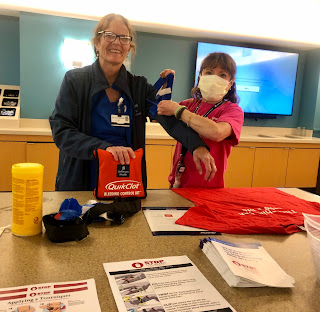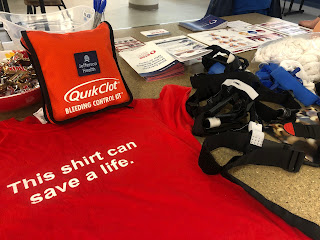May is National Trauma Survivors Month -- and guess what...
You can learn to help someone survive a traumatic injury like mine.
(Yes, really!)
It's called Stop the Bleed.
Now I know what you're thinking. I, too, sat through middle school health class in the 1980's.
And dealing with blood??
That was an even bigger NO.
But you should know (see what I did there?) these important life-saving measures aren't NOs anymore.
First aid and trauma care have evolved since then.
I have it from a good source -- actually the best source -- my Jefferson Trauma Team.
It's okay to help in an emergency.
In fact, it's RECOMMENDED.
 |
| And EVERYONE should know how! |
Stop the Bleed is a nationwide campaign to teach ordinary bystanders how to help someone who's bleeding out.
 |
| With a little knowledge, YOU can save the life of someone who's injured. |
First -- CALL 911. Make sure YOU are safe.
If the person is bleeding, apply pressure to the wound. Both hands. Shoulders strong. Get down on your knees if you have to.
If the wound is wide and deep, pack it with gauze -- or whatever fabric you might have handy.
 |
| Even a t-shirt will work. (Trauma Nurse Nora taught me that!) |
For arm or leg wounds, a tourniquet might be necessary. Learn to use one.
If bleeding is forceful or continuous, apply a tourniquet 2-3 inches above the wound or above the nearest joint. (You can even make one from a cloth or belt.)
It can take an average of 7-10 minutes for first responders to arrive.
We can all learn the basics. Check out Stop the Bleed Project for more information.
This month, I learned the basics and joined the Jefferson Team to help educate the public.
It was just my first step into this important cause. More to come...
 |
| ANYONE CAN BE A HERO. |
P.S. Stop the Bleed Kits and other first aid supplies are readily available - even on Amazon.



Such an important message, thank you. In the past I have helped bystanders, and I hope to continue to be an asset to the public.
ReplyDeleteWhen facing lost luggage while traveling, swiftly report to airline personnel. Fill a claim form, providing details. Stay patient as they track and return your belongings. Prioritize TRAVELpreparedness!
ReplyDelete